The history of employee benefits dates back to 1959, when Congress officially created a health benefits program for federal employees. Nowadays, about 49% of the total American population receives employer-sponsored health insurance. For modern-day employees, however, traditional benefits are not enough. That’s why we prepared the most surprising employee benefits statistics to help you better understand what employees want and what companies must do to stay competitive in the talent market.
Employee Benefits Statistics (Editor’s Choice)
- 80% of workers would choose a job with more benefits over a 30% raise without benefits.
- 66% of workers claim benefits are the most critical factor when choosing a job.
- 61% of employees would take a lower-paying job if it offers a robust benefits package.
- 64% of employers offer wellness resources, and 58% offer general wellness programs.
- 46% of workers would accept a job with lower pay but more flexible arrangements.
- 72% of employees say a better benefits program will increase their happiness.
- 83% of large enterprises plan to continue or expand wellness programs in the future.
- Only three in 10 Americans say they’re using the benefits to their full potential.
Employee Benefits Statistics
1. Companies that offer great compensation and benefits to employees experience 56% lower attrition.
Multiple studies suggest that benefits offered by companies seldom impact the job satisfaction of employees and help them attract and retain talent. The latest job satisfaction statistics show employees value benefits even more than a raise — 80% would go for a job with more robust benefits rather than a 30% raise in salary with no benefits. Better compensation and benefits are the number one reason millennials decide to switch jobs.
(Linkedin, AICPA)
2. Recognition reward programs boost loyalty and job satisfaction according to 79% of millennial and Gen Z employees.
Employee benefit statistics suggest that 70% of Millennial and Gen Z workers would stay at their current job for another year if their employers rewarded them $150 annually. Strong recognition culture is what motivates over 90% of employees to work harder. Lack of recognition is a good enough reason to quit a job for 19% of employees.
(HRDIVE, Achievers)
3. 20.7% of employees would leave their current job for one with better corporate benefits.
Although compensation remains the top reason employees switch jobs, with 54.2% willing to quit for a pay raise and 37.8% doing so in the name of career advancement, work benefits are still a strong reason for leaving. Employee benefits data shows that a whopping 78% of people working for organizations that offer group marketplace benefits to staff say they would remain in their current organization because of the benefits it provides.
(Willis Towers Watson, Cision PR Newswire)
4. 66% of workers say perks and employee benefits are the most determining factor when choosing a job.
Working for benefits, it’s quite common among employees. In the same survey, 61% of employees say they’d take a job with a lower salary if it offered a better benefits plan. Employee retention statistics show that inadequate benefit programs have caused 42% of employees to consider changing their current positions. A whopping 55% have already left a job mainly because they found options with better employee benefit packages.
(HRDIVE)
5. Employee benefits data shows that 94% of employees say they want employee benefits packages that will enhance the quality of their lives.
The majority of the workforce prioritizes employer-sponsored benefits, with health insurance cited as the most crucial benefit, especially among older employees. Retirement and pension plans come in next. Employees’ most desirable corporate perks are early Friday dismissals, remote work or at least flexible work schedules, and onsite amenities such as concierge services or a gym. Almost half of the workers aged 18 to 24 (41%) would like their employers to offer student loan benefits.
(HRDIVE)
6. Workers who are satisfied with their perks and employee benefits are four times more likely to be happy with their jobs.
35% of millennials are more likely to pass on a job proposal because they don’t like its benefits compared to 27% of all other age groups. Employee benefit statistics also show that millennials strongly emphasize benefits customization, with the majority of them reporting it’s important for increasing their loyalty, compared to 67% of baby boomer workers.
(Businesswire)
7. According to 43% of employees, annual leave is the work benefit that would make them feel most loved at work.
Other leading benefits that make employees feel appreciated in the workplace include public recognition, team drinks, training, professional mentoring, sleeping in once a week, and dedicated parking space for a month.
(NORTHSTAR meetings group)
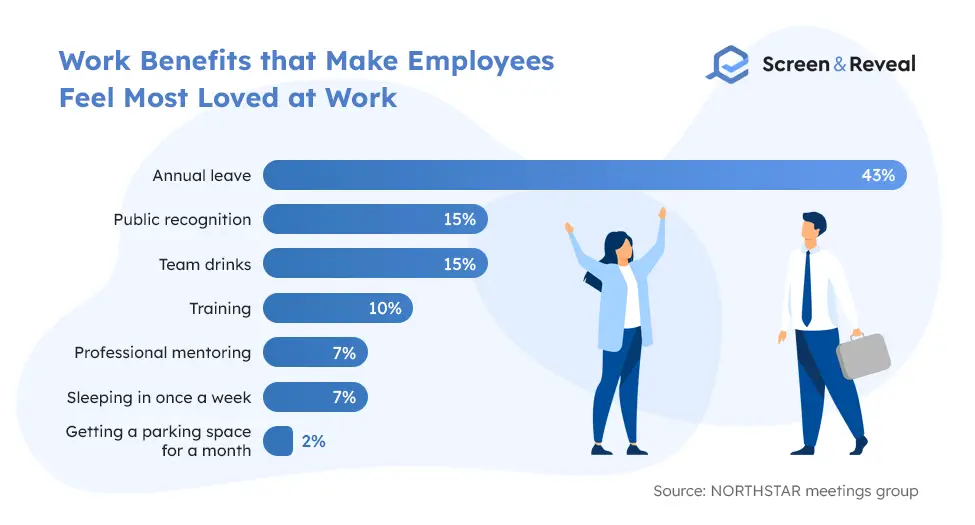
8. Employee bonus statistics unveil that employees prefer personalized, spontaneous rewards over money.
Quite surprisingly, 66% of employees said they’d rather take two concert tickets of their choice than receive cash added to their paycheck three times the value of the tickets. Employee engagement statistics indicate that non-personalized small gifts like chocolate or cake aren’t as desired, where only 35% would rather receive these token gifts instead of money added to their salary.
(NORTHSTAR meetings group)
9. Perks and employee benefits data show that 66% of workers who receive perks are satisfied with the offerings.
As many as 90% see their employer’s wellness program as the most important perk. The majority of employees (68%) think that perks are just as important as traditional benefits like health coverage and life insurance. Still, 42% of full-time employees get no perks.
(Clutch, Stanford University, HRDIVE)
Employee Bonus Statistics
10. 83% of employees expect to receive bonuses.
Research from 2018 reveals more than half of employees (51%) expect to get higher bonuses than those from the previous year. 61% of respondents said their bonus is directly connected to their annual performance review, while 39% said it doesn’t play a role in the bonuses. The majority of employees (90%) cited their organization’s performance as the main determinator of the amount they’ll receive in bonuses, compared to 10% who responded negatively. As many as 71% of employees receive bonuses in cash.
(SHRM)
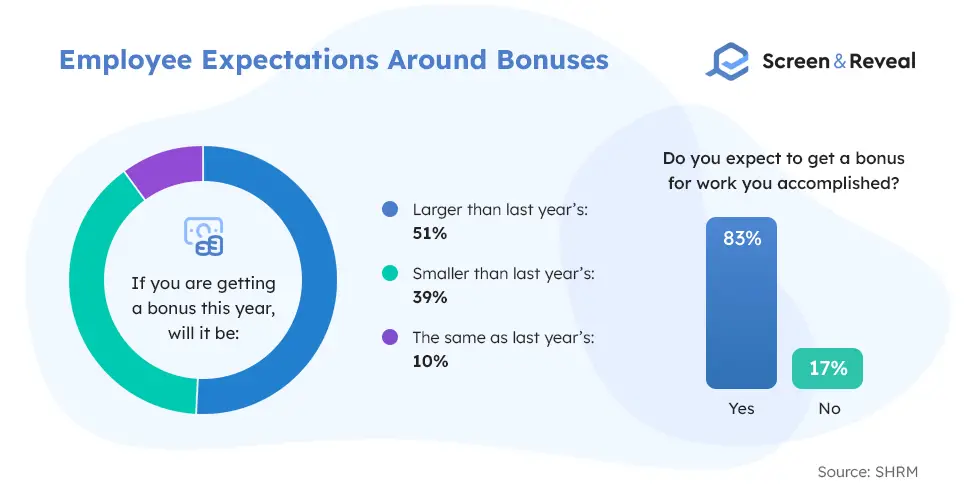
11. Employee bonus statistics suggest that 90% of workers would rather receive bonuses or extra time off than attend a company-sponsored event.
Aside from cash bonuses, 30% of employees would prefer to receive incentive rewards in the form of paid vacation time, 20% of employees would like flextime, 18% favor more time off, and 11% sabbatical leave.
(CISION PR Newswire, SHRM)
Voluntary Benefits Statistics
12. 62% of employees under 50 wouldn’t consider a company if it didn’t offer voluntary benefits to employees.
Overall, 79% of employees recognize voluntary benefits as a necessity. Employers seem to listen, as there has been a 138% increase in companies offering at least three voluntary benefits since 2016. Still, 45% of employees report their organizations don’t offer voluntary group life insurance, and the same percentage claims their employers offer such benefits.
(Benefitspro, CISION PR Newswire, HRDIVE, Access Perks)
13. According to voluntary benefits statistics, 83% of employees with healthcare benefits would enroll in voluntary benefits even if their employer doesn’t cover them.
Employers widely use voluntary benefits as a way to stay competitive in the talent market, and half of them claim those constitute a significant part of their company’s benefits strategy. 87% of companies that offer these types of benefits for employees feel they matter to their team.
(BenefitsPro)
14. Companies that offer voluntary benefits have reported higher levels of employee satisfaction.
Job satisfaction went from 65% to 69% when employees were offered voluntary benefits, and it reached 75% in organizations where employees enrolled in these programs.
(HR Daily Advisor)
Flexible Employee Benefits Statistics
15. 46% of employees will take a job with lower pay if it offers more flexible working arrangements.
Employees cite work-life balance as the top reason they want to work flexible schedules (75%), followed by family-related reasons (45%), time savings (42%), and commute stress (41%). A whopping 80% of employees say they would be more loyal to their current organization if given job flexibility, and more than half have already tried to negotiate flexible work. Fully remote work is the most preferred type of flexible work among employees as half of them believe it will positively impact their overall quality of life. 78% of them believe it would improve their health.
(FlexJobs)
16. Employee benefits data suggests that 36% of parents would’ve continued working if their jobs were more flexible to meet their needs.
Still, many employers make at least some effort to accommodate working parent needs, with a majority offering remote work or flexible work locations or schedules, additional unpaid leave, parent support groups, coaching support, and returning to work after parental leave. A smaller percentage of employers also offer overnight breast milk delivery services for mothers who travel for work and concierge services for new parents.
(Flexjobs, Benefitnews.com)
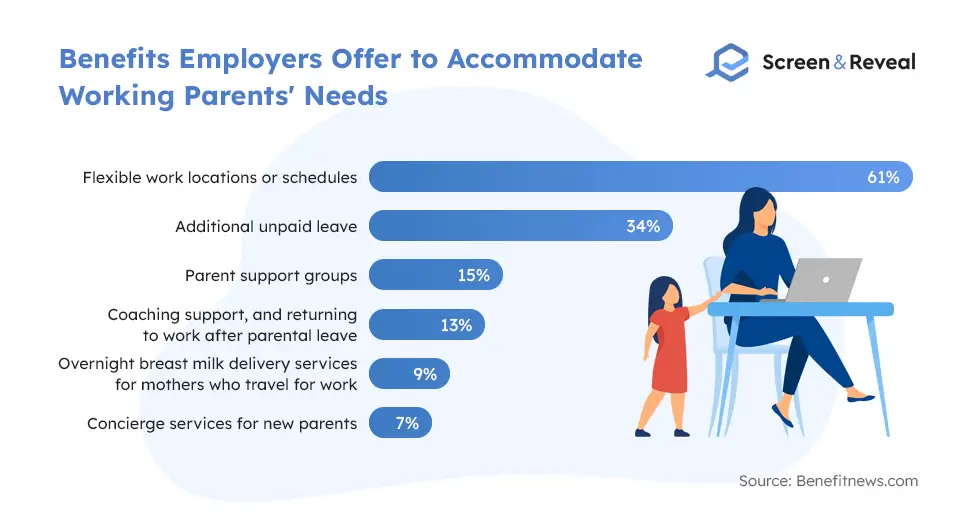
17. 63% of businesses have noticed at least a 21% increase in productivity due to flexible working.
Aside from keeping everyone safe during the pandemic, businesses adopt flexible working for various other reasons, employee benefit trends show. 81% find expanding their talent pool to be the key driver to adopt flexible work policies, 70% choose flexible working to help them scale, 65% of companies do so to reduce capital and operational costs, the same percentage of organizations have adopted flexible working to manage risks better and consolidate their portfolios. Given that 80% of employees say they’d choose a job that offers flexible work over one that doesn’t, and 74% of workers believe flexible work is the new norm, it’s no wonder that 83% of employers have introduced flexible work policies in the past decade.
(CISION PR Newswire)
Employee Benefit Trends
18. Health insurance and 401(k) or equivalent are the most important benefits for employees across all organization sizes, generations, genders, and industries.
85% of all employees consider health insurance a must-have benefit, 10% say it’s nice to have it, and 4% think it is unnecessary. Other benefits scoring the highest among employees are 401(k) or similar, paid and unpaid leave, dental, vision, and life insurance.
(MetLife)
19. Employees are increasingly interested in benefits that support safety, protection, and well-being amid the Covid-19 outbreak.
72% of employees state safety and protection as more important than ever before, and 62% think that benefits are now more important than ever due to the pandemic. Employee benefit trends further show that 60% would like their employer to offer a broader mix of non-medical benefits so they can choose and purchase on their own. Lastly, 51% say their employers should make more significant efforts for their safety and protection, and 39% state their employers aren’t offering benefits that support or improve their well-being.
(MetLife)
20. 55% of employees in their 20s, including Gen Zs, are happier with their current working conditions than before the pandemic.
A key reason for increased satisfaction among younger generations is the flexible schedule and remote work options. Employee benefit statistics reveal that half of Gen Zers and workers in their 20s say they have a better work/life balance now than before the pandemic, compared to only one-quarter of baby boomers who feel the same. 68% of employees who can work remotely think their employers should give them a chance to decide what’s best for them and their families.
(MetLife)
21. Employee benefit trends show that 80% of employers are increasing benefit communications.
As high as 74% of employers are introducing added-value services like mental-health programs and EAPs, or they intend to do so in the near future, followed by 66% of employers expanding their voluntary benefits for employees or planning to do so. Additionally, 75% of employers encourage greater customization of their employee benefits, 70% invest in new emerging benefits, and 64% enrich the non-medical insurance range.
(MetLife)
22. 72% of employees rank work-life management benefits among the top five most desired types of benefits.
In response to employees’ desires and the Covid-19 pandemic, 44% of employers plan to invest in work-life management programs. Workers who feel their employers provide the desired flexibility are 57% more resilient and 40% more productive.
(MetLife)
23. Due to the Covid-19 pandemic, over half of the workers are more concerned with their financial health than any other element of their well-being.
Employee benefits data shows a gap between what employees desire and what employers intend to do. 64% of employees rank financial as the top company benefits. Still, only 37% of companies intend to expand their benefit programs with such benefits after the pandemic. Employers must build employee benefits packages that address post-pandemic needs. The top reasons for financial stress and anxiety among employees are the ability to retire on schedule and long-term savings like 401(k), IRAs, and other retirement accounts. Next on the list is the cost of living, followed by medical and health expenses and additional unexpected costs.
(MetLife)
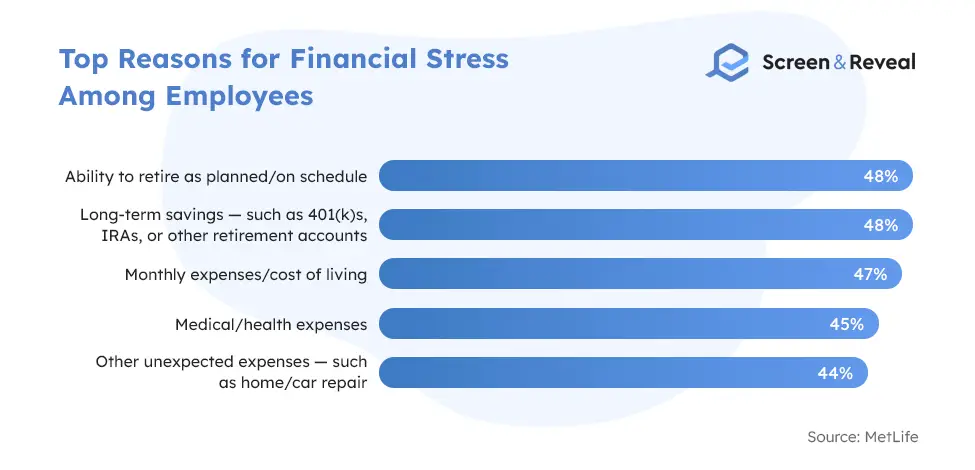
Small Business Employee Benefits Statistics
24. Small organizations are more likely to cover their full-time employees’ benefits cost fully.
Larger organizations, however, are more likely to share the expenses with part-time employees. 28% of organizations with fewer than 100 employees pay the total cost for their full-time employees’ benefits compared to 71% of them that share the cost with their employees. About 12% of midsize employers cover the total cost of health insurance, while 87% share it with their full-time employees. Only 9% of large firms employing 500+ people cover their employees’ total health insurance cost, while 88% share it.
(SHRM)
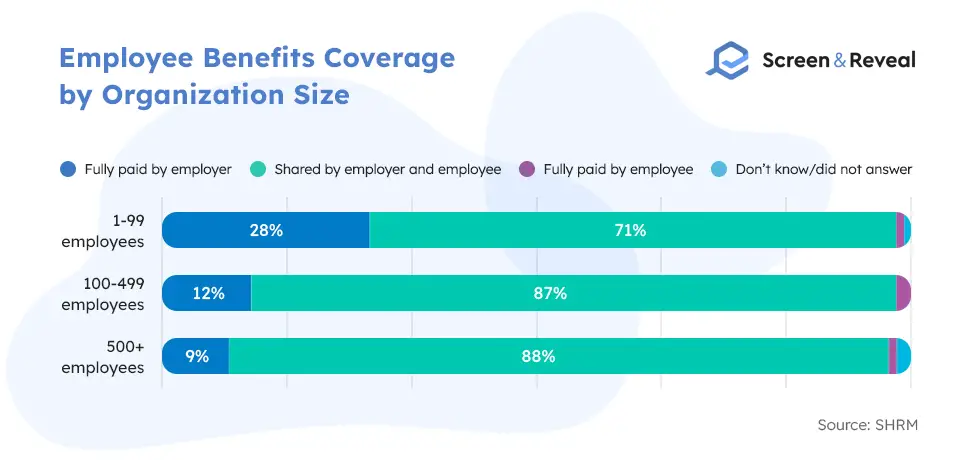
25. According to employee benefits statistics, 59% of small businesses provide healthcare benefits to full-time employees compared to 85% of all employers.
In 2019, annual premiums for family coverage averaged $20,576, with employers covering about 71% of that cost. Families chipped in with an average of $6,015 a year. The individual premiums averaged $7,188, with workers covering $1,242 or 17.2%.
(Kaiser Family Foundation)
26. Employee benefit statistics show that 26% of employees working for small businesses would transition to a larger organization for better benefits.
Half of the small-business employees cite benefits as extremely or very important to their happiness. Most employees working for small organizations (72%) state that improving their benefits program will increase their happiness. Satisfaction with current benefits varies, with 33% satisfied with their current benefits, 20% disappointed, 13% happy, and 3% angry.
(Benefitspro.com)
27. 44% of small-business employees state PTO is a significant benefit, and four in 10 small businesses offer it.
Additionally, 21% believe that PTO benefits have a positive impact on team performance. Small business employee benefits statistics show that nearly half of small-business workers would accept a lower-paying job in exchange for more PTO. It’s also one of the most commonly provided benefits among small businesses, with 41% of organizations offering paid leaves to their employees.
(GlobeNewswire, Clutch)
28. Employ requests account for the primary reason why nearly 30% of small businesses plan to introduce new benefits.
Employee reduction is the second biggest reason that drives small businesses to offer new benefits to employees, followed by financial growth, legal requirements, and union negotiations.
(Clutch)
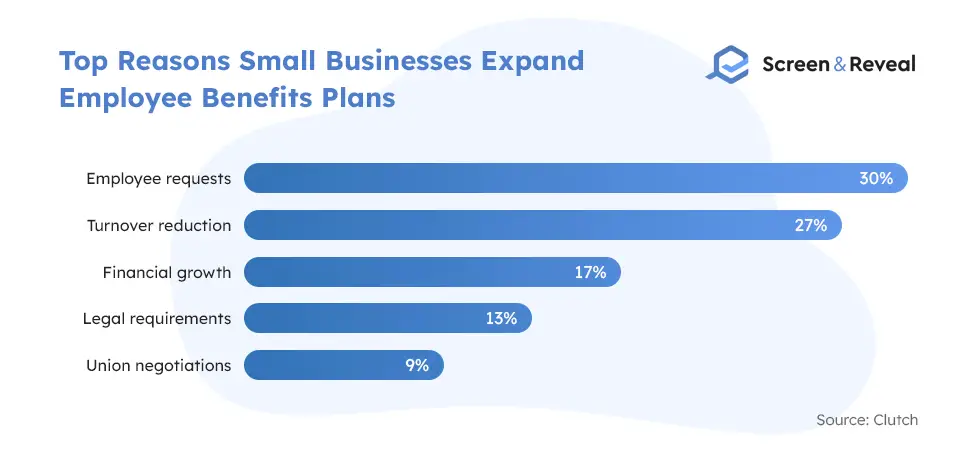
29. 71% of small businesses plan to provide the same benefit programs for their employees.
According to small business employee benefits statistics, only five percent of businesses intend to expand their employee benefits packages with at least one new benefit, while 21% plan to cut a benefit without adding anything new, and 3% plan to drop a benefit in favor of a new benefit. Of those not excluding benefits, a quarter intends to increase the portion of the premiums that employees cover, while less than one-fifth plans to increase their share.
(Unum)
30. With 27%, flexible scheduling is the top reason employees like to work for small businesses.
With 23%, seeing the fruits of their labor is the second biggest reason people prefer small businesses, followed by feeling that their input matters with 17%, getting rewards for their hard work with 14%, and getting recognition among people who matter with 9%.
(HRDIVE)
31. Employee benefit trends show that the demand for flexible talent is growing among small businesses, with 53% utilizing it.
Upwork’s report has estimated that this number will grow by 20% or more in the next decade. Still, due to pandemic factors, small businesses have most of their employees work from remote locations. 60% of small businesses recognize that remote work is the new norm compared to three years ago when the interest in introducing remote work policies wasn’t a priority, remote work statistics show.
Employers that rely on freelancers to fill in talent gaps should perform pre-employment checks on these individuals. With many employment background check companies offering international screenings, you can hire candidates from all over the world with confidence.
(Upwork)
32. For 70% of small-business employees, having flexible schedules is very important.
The majority of small-business employees (68%) say that flexible working has positively impacted their teams. Employers have listened to workers’ requests, with 86% making progress towards developing a more flexible talent strategy.
(GlobeNewswire)
Employee Health Benefits Statistics
33. 64% of employers provide wellness resources and information.
58% of employers offer general wellness programs, up from 44% in 2018. Within those programs, dependent care flexible accounts have declined by 8%, personal and life coaching has reduced by 13%, but standing desks have shown a 7% increase, and there’s a slight boost in child benefits. Employers compensate for the decline in traditional benefits with more creative, niche-focused options applied directly to the workspace like wellness spaces, services, and tools. These offerings usually promote mental health, stress relief, and relaxation.
(SHRM)
34. Of all employers offering wellness programs, 77% offer a lifestyle management program, and 56% provide disease management.
Employee health benefits statistics show that preventive interventions and health promotion activities are highly prevalent among employers. On-site vaccinations are among the most popular health benefits for employees available at 76% of employers, along with 55% of them offering fitness benefits, 44% providing a nurse line, and 21% offering healthy food options in the workspace.
(RAND)
35. 72% of employers offering wellness programs provide both screening and intervention benefits.
The majority of employees support screening and intervention activities, yet 18% provide intervention only, while 11% limit their support to screening activities only.
(RAND)
36. In 2019, 31% of employers provided onsite health screening programs.
To cut healthcare costs and ensure optimal employee health and performance, a fair portion of all employers offer onsite screening services. According to employee health benefits statistics, nearly half of employees, 46% more precisely, take advantage of these screening benefits by undergoing a clinical screening and completing HRA. Employees even use various incentives to increase employee participation in screening activities.
(RAND)
37. A whopping 83% of large employers intend to continue or expand wellness programs in the near future.
Given the importance of health benefits to employees, wellness programs are prevalent in the corporate world, emphasizing financial incentives. Namely, 83% of large employers offer financial wellness programs to their employees, and 14% intend to include financial offerings in the next one or two years. Given that roughly 56% of employees have admitted theyâre stressed about their financial situation, financial wellness remains among the top company benefits for large employers.
(Anthem National Accounts)
38. In 2019, 79% of employers offered two or more healthcare plans, while only 20% of companies offered one health care plan.
Employee health benefits statistics show that preferred Provider Organizations (PPOs) are the most popular health benefits for employees, with 85% of employers offering PPO options. PPOs have an average enrollment of 48% among covered employees. Being provided by 59% of organizations and boasting a 29% enrollment, high-deductible health plans (HDHP) are on the rise as they offer more freedom to employees in decisions about their healthcare spending and are typically less expensive for employers. Health maintenance organization plans (HMO) come in next, followed by Point of Service plans (POS) and Conventional (indemnity insurance) plans.
(SHRM)
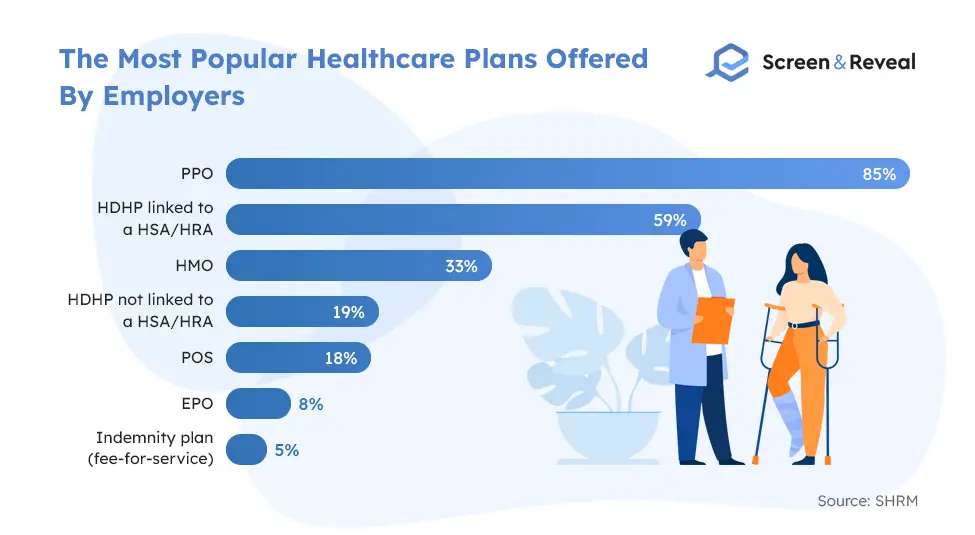
39. Employee benefits statistics suggest that 44% of companies have improved their medical benefit programs as part of their strategy for attracting talent.
With unemployment rates reaching an all-time low of 3.9% in 2018, employers face challenges attracting and retaining top talent. A staggering 85% of millennials say health insurance is an “absolutely essential” or “very important” benefit. Given that this generation comprises the most considerable portion of the workforce, employers have been heavily focused on improving their health and wellness offerings.
(Anthem National Accounts)
40. 71% of employers integrate their benefits programs or consider integration.
Employee benefit statistics further show that out of that 71%, 46% of employers have already integrated their benefits programs, while 25% are heavily considering to start doing so. Furthermore, 24% are looking at potential integration in the future. National and large employers are leading the way to integration, with 75% and 68% inclusion, respectively, while 60% of small groups actively integrate or consider integration.
(Anthem)
41. In 2018, only 18% of employers with 200+ employees provided retirement health benefits for employees.
Retirement health benefits are rarely offered even by large organizations. Some companies that don’t sponsor retirement health benefits help employees through alternative initiatives that don’t affect their budget, like encouraging employees to increase contributions to tax-advantaged accounts.
(Kaiser Family Foundation)
42. Employee benefits statistics suggest that offering benefits to part-time employees is on the rise as employers are trying to attract talent.
Still, part-time employees are more likely to fully pay for their benefits, resulting in 26% employed in small firms, 16% working for mid-size companies, and 14% employed by large companies covering the total cost of their health insurance. Regarding sharing, large enterprises are most willing to split the health plan costs with their part-time employees. Only a few percent of companies of any size are eager to cover their part-time employees’ total health benefit costs.
(SHRM)
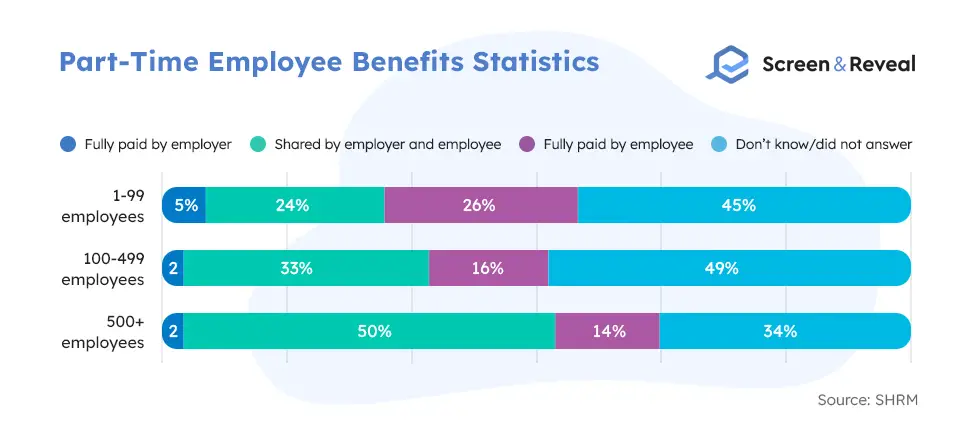
43. Employee benefit statistics show that only 4% of employers provided nap rooms to their employees in 2019.
While the benefits of power naps and quality sleep are more discussed than ever, and employers offering nap rooms are getting quite a lot of press, in reality, only a small portion of organizations have implemented such a benefit. Quiet rooms are far more popular, provided by 21% of companies, encouraging meditation, praying, and rest at work.
(SHRM)
44. Employee health benefits statistics suggest one-third of employees provided offsite or onsite fitness benefits to their workers in 2019.
Employers continue to support workers’ physical wellbeing through onsite fitness rooms or offsite fitness centers, classes, or reimbursement for memberships related to physical activities. 32% of companies offer offsite fitness benefits, and slightly less, 29% of employers provide those benefits onsite. Some companies go even further, providing wellness tools like fitness bands and activity trackers to encourage higher physical activity among employees.
(SHRM)
45. 40% of employees find dealing with multiple vendors for their benefits confusing, yet 54% of employers offer benefits on different platforms, adding to the frustration.
Since most employers use different vendors to offer benefits, employees are left with multiple logins and a complex process to access their benefits. Employee benefits data shows that roughly 50% of employees say they can’t access their benefits the way they would like to, with only 21% saying it’s easy for them to access their benefits. Of those who find it easy to access their benefits, 81% say they feel loyal to their organization, and 79% say they are proud to work for their employer. Employees also have higher expectations, with 73% wanting to have 24/7 access to their benefits.
(HealthAdvocate, The HR Tech Weekly)
46. Only three in 10 Americans say they’re taking full advantage of their benefits.
Data suggests that most Americans aren’t using their benefits to their fullest potential. However, nine in 10 employees, or 88%, say they understood all the benefits available to them when they started working for the organization. 86% of employed American adults keep up with the changes in benefits, and the same percentage of employees claim they know where to access information about their benefits. According to employee benefits statistics, only 28% of employees are confident they utilize their benefits to the fullest.
(AICPA)
47. 81% of organizations that offer benefits to employees believe their benefit programs increase employee satisfaction.
Additionally, 68% of organizations are confident that their employees have enough resources and options to meet their health care and financial obligations. 61% of employees say they’re satisfied with the benefits available to them. The majority of employees (85%) recognize a need for voluntary insurance benefits.
(HR Daily Advisor)
48. 70% of workers are comfortable sharing personal health information with their organizations to receive more personalized health guidance.
With 79%, millennials are the most willing to share personal health information, followed by Gen X with 70% and baby boomers with 56%, employee benefits statistics show. Workers are less comfortable sharing financial information, with 67% of millennials, 59% of Gen Xers, and 44% of baby boomers willing to share it to receive more personalized financial guidance.
(Alight)
49. 55% of employees say health coverage is the most vital driver for job satisfaction.
A smaller portion of employees (18%) cited paid vacation, 11% chose overtime pay, and 10% stated retirement plans are the most significant driver for job satisfaction. However, health coverage is leading the game, keeping 56% of employees in their current jobs. Employers also understand the importance of great health coverage plans, with 68% of them believing their health benefit programs affect their reputations and contribute to increasing employee satisfaction and morale.
(Clutch, AHIP, Businesswire)
50. According to employee health benefits statistics, 73% of employees consider health and wellness programs when deciding whether to accept or turn down a job opportunity.
Regarding gender, health and wellness programs are more important to men with 79%, compared to 65% of women.
(Robert Half)
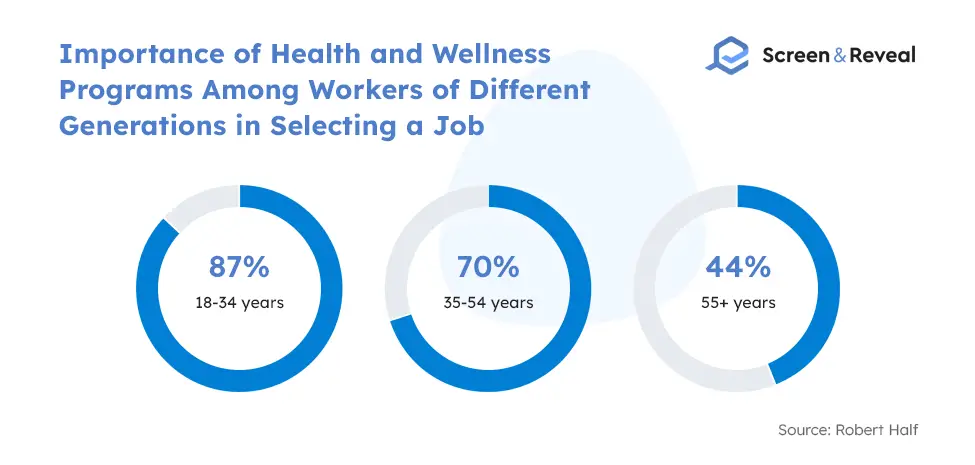
FAQ
How important are benefits to employees?
Employee benefit statistics show that 61% of employees would take a lower-paying job if it provided a more robust benefits package, underscoring the importance of benefits. 38% of employees are willing to pay more each month for better healthcare coverage, and 46% are willing to pay more if the plan offers more predictable healthcare costs.
What benefits do employees want?
According to employee benefits statistics, 85% of employees consider health insurance a must, with benefits such as 401(k) or another equivalent, paid and unpaid leaves, and dental insurance among the most desired employee benefits.
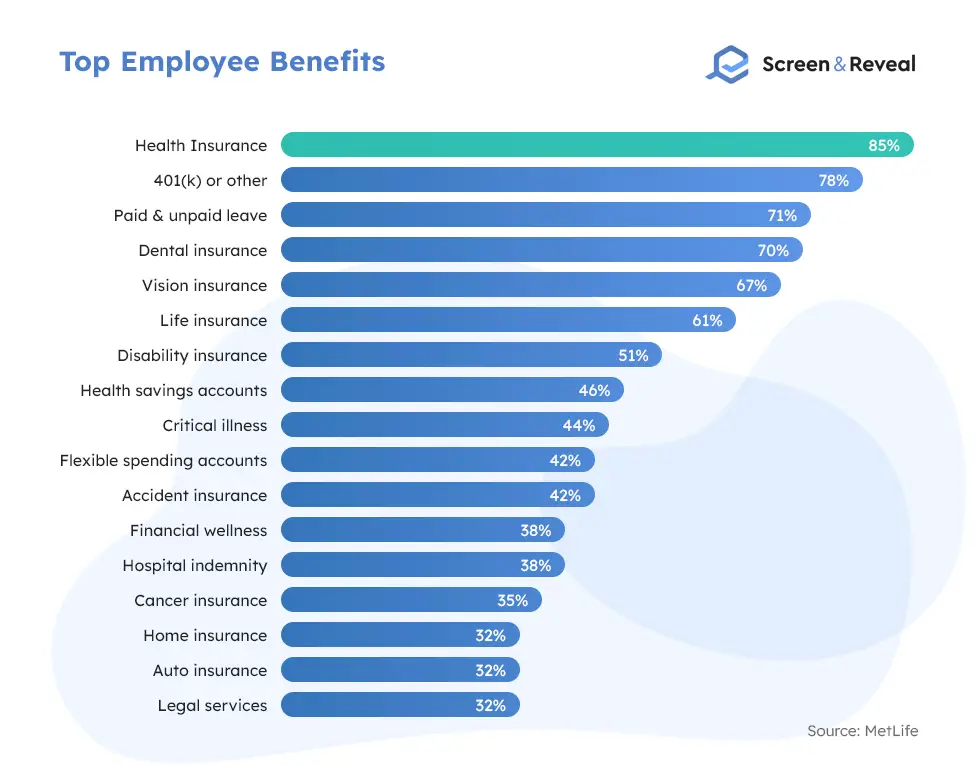
What benefits do employees value most?
Employee benefit statistics suggest that employees consider health insurance, 401(k) or another equivalent, PTO, and unpaid leaves as the most valuable employee benefits.
Which benefit costs do companies see as their biggest worry?
Unstable costs are more challenging for companies to plan and accommodate. Healthcare benefits costs are the biggest worry for employers as these costs have dramatically increased over the years. Retirement plans are another unpredictable category that raises concerns among companies.
What is the average percentage of employee benefits?
According to the latest employee benefits statistics, employee benefits account for 31% of an employee’s total compensation for employees working in the private sector and 38.3% for employees part of the public sector.
What are the 4 major types of employee benefits?
All traditional benefits fall under the following four major categories:
- Medical insurance
- Life insurance
- Disability insurance
- Retirement plans
Sources: Linkedin, AICPA, HRDIVE, Achievers, Willis Towers Watson, Cision PR Newswire, HRDIVE, Businesswire, NORTHSTAR meetings group, Clutch, Stanford University, HRDIVE, SHRM, CISION PR Newswire, Benefitspro, CISION PR Newswire, HRDIVE, Access Perks, HR Daily Advisor, FlexJobs, Flexjobs, Benefitnews.com, CISION PR Newswire, MetLife, MetLife, SHRM, Kaiser Family Foundation, Benefitspro.com, GlobeNewswire, Clutch, Unum, HRDIVE, Upwork, SHRM, RAND, Anthem National Accounts, Anthem, HealthAdvocate, The HR Tech Weekly, Alight, Clutch, AHIP, Businesswire, Robert Half, GlobeNewswire, Foorquiz, U.S Bureau of Labor Statistics.

